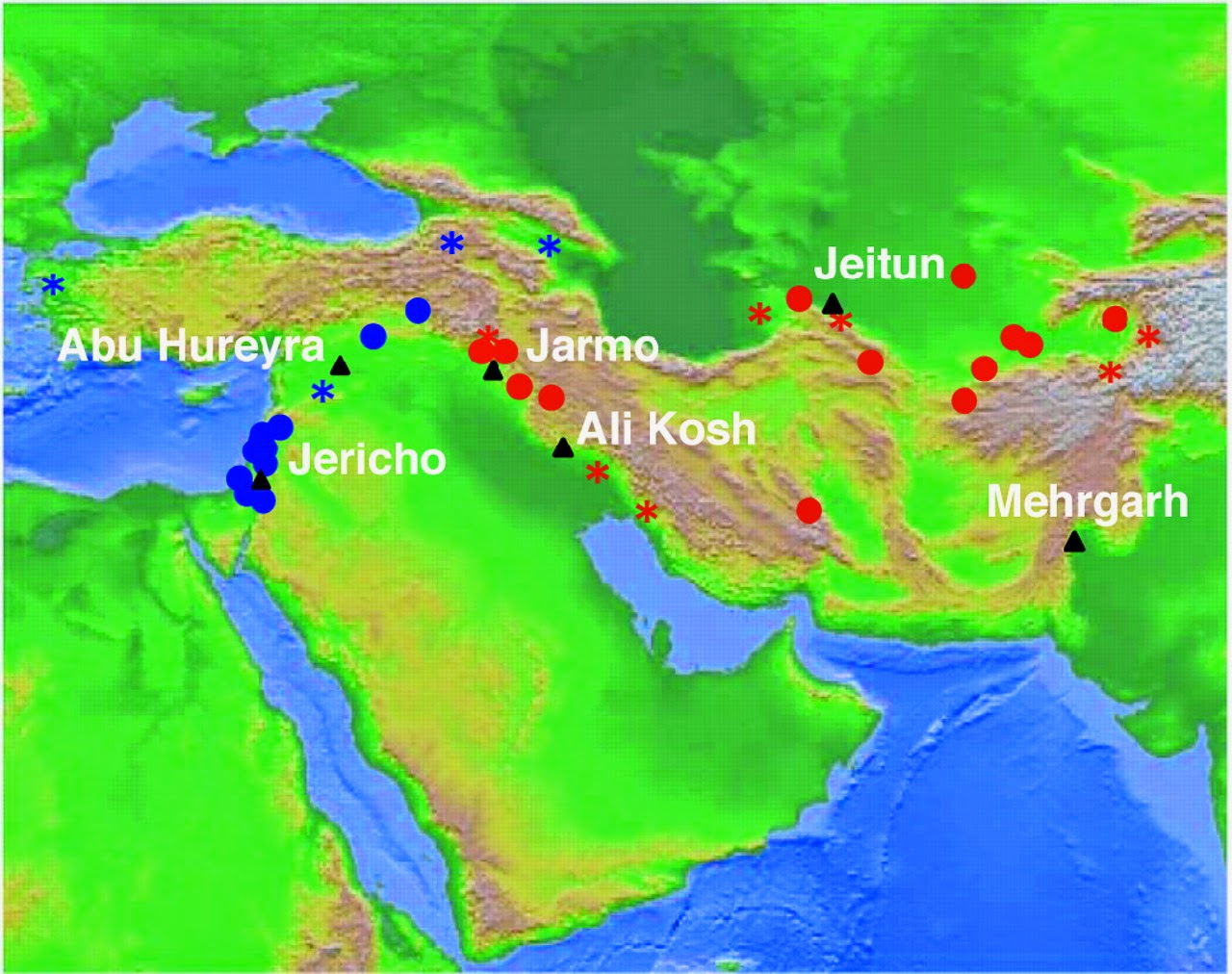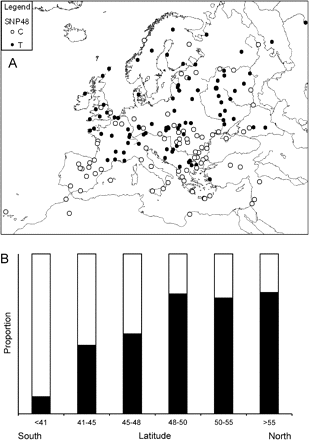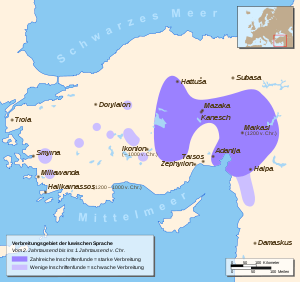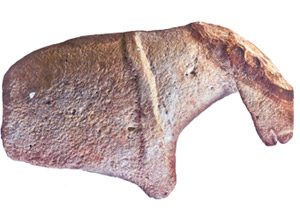The real position of the cradle of Indo-Europeans has been to me a fascinating enigma since I learned about this mysterious 'people', and I often dreamed about a research project on that, but never daring to propose one in a real academic context. I am an Indologist with some knowledge of historical linguistics, and Indo-European studies are for me a sort of hobby, implying sciences that I have not properly studied like archaeology, genetics, physical anthropology. Anyway, in the last days, having finally some time after conferences and applications, I have looked again at the topic, starting from a remarkable passage of an important book.
Previously in this blog, I have already cited the great work of Bernard Sergent on Indo-Europeans (Les Indo-Européens. Histoire, langues, mythes, Paris 1995), that I could buy more than two years ago in a shop of secondhand books in the 5th arrondissement of Paris, kept by Armenians. The price was not cheap, but it looked like an interesting and rich book, and now I can confirm that even more. Sometimes it is impressive how the fortuitous finding of a book can influence your future ideas and research, that is, if you are a researcher, your life itself. At p.432, in the chapter about Indo-Europeans and archaeology, it is written that the lithic assemblage of the first Kurgan culture in Ukraine (Sredni Stog II, identified with the Indo-Europeans by Gimbutas), coming from the Volga and South Urals (p.399), recalls that of the Mesolithic-Neolithic sites to the east of the Caspian sea, Damdam Chesme 2 and the cave of Dzhebel, where there are already individual burials in a flexed position and breeding of sheep and goats. Therefore, Sergent adds, the authors who have remarked this similarity have concluded that the men who settled on the Volga came from the region of Dzhebel. He writes more precisely that the people of the first Kurgan phase are ancient Mesolithic people of Dzhebel who, having learned agriculture, have brought it to the Volga. Thus, he places the roots of the Gimbutas' Kurgan cradle of Indo-Europeans in a more southern cradle. But he does not stop here. He adds that the Dzhebel material is related to a Paleolithic material of Northwestern Iran, the Zarzian culture, dated 10000-8500 BC, and in the more ancient Kebarian of the Near East. He also remarks that the mutton appears to be domesticated at Zawi Chemi Shanidar, one of the most important Zarzian sites, from 9000 BP, as it is later in Dzhebel. Then, he adds the linguistic remark that many authors consider the Indo-European language related, first of all, to the Semitic-Hamitic linguistic family, because of root structure (with 2 or 3 consonants), grammar (the fusional system instead of agglutinative), phonetics (including laryngeals), and a very important common vocabulary, especially with Semitic, for instance the number seven, and he adds that there is a rich comparative material showing that all seven first numbers are common between Indo-European and Semitic. He concludes (p.434) that more than 10000 years ago the Indo-Europeans were a small people close to Semitic-Hamitic populations of the Near East.
I had already an idea of Sergent's theory from the writings of K. Elst, nonetheless when I read it in detail in this book, I found it surprising and intriguing, and I tried to know more about Dzhebel and Damdam Chesme, but I could not find much. I did not give the due importance to the Zarzian element, actually I had a prejudice about the Zagros area, that I used to identify with the Elamite culture and language. But only a southwestern part of the Zagros mountains was part of Elam in historical times. The Zarzian sites are more to the north: Zarzi, Palegawra and Zawi Chemi Shanidar are in the Iraqi Kurdistan, to the east of Kirkuk and Erbil. In the Wikipedia description of the Zarzian culture (apparently taken from A. Burns, cp. this post), we read this sentence: "The Zarzian culture is found associated with remains of the domesticated dog and with the introduction of the bow and arrow. It seems to have extended north into the Kobistan region and into Eastern Iran as a forerunner of the Hissar and related cultures." Kobistan is more often called Gobustan, in Azerbaijan, while the Hissar culture normally indicates a Neolithic culture in northern Afghanistan and southern Tajikistan.
Doing research on Google on these topics, I have found again and again the Zagros area as the source of different cultures in areas associated with Indo-Europeans, already in the Mesolithic. In the book edited by Zvelebil Hunters in Transition: Mesolithic Societies of Temperate Eurasia and Their Transition to Farming, we find this strong statement (p.138) by G. Matyushin:
the geometric microliths and points found in the mesolithic sites of the southern Urals are identical with the inventory of the remains found in Belt Cave, Hotu, Shanidar B, Karim Shahir, Zawi Chemi Shanidar, Jarmo and other sites in southwestern Asia - the area of the origin of domestication during the tenth to eighth millennium bc.
Now, these sites are in two areas, the South Caspian region and the northern Zagros. In the previous page, the same author writes: "Sudden ecological changes at the end of the Pleistocene led to the penetration of the southern Urals by South Caspian populations, with the result that a unique culture (Yangelskaya)... developed in the area." At p.143, he observes that "anthropological data provide further evidence for the arrival of population from the south to the Urals, in the Mesolithic." For example, a burial in Davlekanovo under a hearth containing ceramics of the Mullino II type (Neolithic) had a skeleton with clear 'mediterranoid' characteristics.
At p.124, Dolukhanov writes about the cave sites at Dam-Dam-Cheshma 1 and 2, and Dzhebel in Western Turkmenistan (east of the Caspian sea, as already said), that their Mesolithic assemblages belonged, according to Korobkova, to two kinds of industries: one related to the Belt and Hotu caves, one to the Zarzian. The Zarzian again, confirming what was said by Sergent. So, we have a route going from the northern Zagros to the South Caspian to the East Caspian to the southern Urals. A route followed by Mesolithic hunters, but in the same sites we often find later domesticated goats and sheep. And, as observed by Matyushin at p.141:
Sarianidi, at p.115 f. of the History of Civilizations of Central Asia, vol.1, remarks that the same region contained Late Mesolithic caves of hunters and gatherers and sedentary villages with an economy of production, and that the earliest Neolithic sites are not those of Turkmenistan (Jeitun culture), but of northeastern Iran close to the Caspian region, where there are also Mesolithic caves, like Dzhebel and Damdam Cheshme, used as shelters by hunters even in the Early Mesolithic period (10th to 7th mill. BC). In the Dzhebel cave and Damdam Cheshme 2 domesticated animals, however, appear comparatively late, in upper Neolithic strata, suggesting that they arrived there in a fully domesticated form. And although wild sheep and goats roamed in the area, the domesticated varieties appear to have descended not from the local strains, but from those of western Asia.
At p.124, Dolukhanov writes about the cave sites at Dam-Dam-Cheshma 1 and 2, and Dzhebel in Western Turkmenistan (east of the Caspian sea, as already said), that their Mesolithic assemblages belonged, according to Korobkova, to two kinds of industries: one related to the Belt and Hotu caves, one to the Zarzian. The Zarzian again, confirming what was said by Sergent. So, we have a route going from the northern Zagros to the South Caspian to the East Caspian to the southern Urals. A route followed by Mesolithic hunters, but in the same sites we often find later domesticated goats and sheep. And, as observed by Matyushin at p.141:
Taking into account that wild sheep are absent from the Urals and the surrounding areas, and that their region of origin was northern Mesopotamia and northern Iran, it can be assumed that stockbreeding was introduced to the Urals from Iran and the southern shores of the Caspian. The introduction of the 'southern' stockbreeding elements may date well back into the Mesolithic, possibly to the date of the appearance of the geometric microliths (ninth to seventh millennia bc).However, according to the table that he gives at p.143, ovicaprids are attested in South Urals only a short time before 6000 BC.
Sarianidi, at p.115 f. of the History of Civilizations of Central Asia, vol.1, remarks that the same region contained Late Mesolithic caves of hunters and gatherers and sedentary villages with an economy of production, and that the earliest Neolithic sites are not those of Turkmenistan (Jeitun culture), but of northeastern Iran close to the Caspian region, where there are also Mesolithic caves, like Dzhebel and Damdam Cheshme, used as shelters by hunters even in the Early Mesolithic period (10th to 7th mill. BC). In the Dzhebel cave and Damdam Cheshme 2 domesticated animals, however, appear comparatively late, in upper Neolithic strata, suggesting that they arrived there in a fully domesticated form. And although wild sheep and goats roamed in the area, the domesticated varieties appear to have descended not from the local strains, but from those of western Asia.
 |
| Damdam Cheshme cave |
The southern Urals where the Zarzian people apparently arrived through the Caspian region are close to the area of the Samara culture on the Volga of the late 6th-early 5th millennium BC, regarded as the origin of the Kurgan Indo-European cultures. About the Neolithic period in the southern Urals, in Prehistoric Russia, p.130, it is written:
At p.142, about the Yamnaya stock-breeding:Some scholars (N.Ia. Merpert) suggest that the Yamnaya culture emanated from the south of Soviet Central Asia; graves of Zaman Baba I, Djebel, etc. have been mentioned. The influence emanating from the Kelteminar culture had evidently reached the South Ural culture (Cherbakul II) of the Middle Neolithic. The tribes who lived in the area bordering on the Urals to the west, the presumed ancestors of the Yamnaya people, were most probably influenced as well.
Stock-breeding was not an invention of the Yamnaya people. They may have learnt it from the west Siberian tribes, their eastern neighbours, and, if so, it was of Central-Asiatic, Iranian derivation.And about the "Central Asiatic centre of early agriculturalists":
only very late in its development did it influence the neighbouring Mesolithic tribes in the country further North. The earliest of the latter peoples to learn about pottery were the men of the Kelteminar culture, which was formed about the beginning of the third millennium. A pottery closely related and presumably taken over from the Kelteminar culture, appeared soon in the region of the south Urals, further North in the Gorbunovo culture, and also in the Kama and Kazan cultures west of the Urals. All these cultures belonged to a wider Ural/West-Siberian Kulturkreis. The Kelteminar pottery, which seems to be the earliest, was probably adopted from the Anau or Namazga cultures of the southern part of Soviet Central Asia.
The Neolithic Kelteminar culture, dated 5500-3500 BC, spread from northern Turkmenistan to Kazakhstan. Its stone industry had common elements with the Caspian, Ferghana and Hissar cultures (see here and here). It is remarkable that all these areas, when they first appear in history, belong to Iranian cultures. According to the Wikipedia entry, the Kelteminar people were Mesolithic groups coming from the Hissar area (South Tajikistan/North Afghanistan), with bow, arrow and dog. And we have already seen how the Hissar culture has been derived from the Zarzian.
But there is another route from the Zagros through the Caspian. Sarianidi speaks at p.124 of the Mesolithic strata of the 9th millennium BC at Kara-Kamar in northern Afghanistan and adds: "It has been suggested that like the Ghar-i Kamarband [Belt cave] and Hotu caves, Kara-Kamar reflects the spread of Mesolithic people from the Zagros mountains to the northern foothills of the Hindu Kush via the Caspian coast." And the route could go further east. In The Agricultural Revolution in Prehistory : Why did Foragers become Farmers? by G. Barker, although the thesis is that at Mehrgarh in Baluchistan agriculture starts indipendently from South-West Asia, it is observed at p.162 that in Neolithic Mehrgarh the technology "included geometric microliths such as those used by the late Pleistocene and early Holocene foragers of the Zagros and Turkmenistan." J.F. Jarrige and M. Lechevallier, in an article in French of 1980, Les fouilles de Mehrgarh, Pakistan : problèmes chronologiques, observe that the trapezoidal microliths of Neolithic Mehrgarh are characteristic of the Mesolithic sites from the Kizil Kum, near the Caspian sea, to the left bank of the Amu Darya in Afghanistan.
But leaving aside the remnants of the Mesolithic period, also the new Neolithic elements point to an origin from the Zagros. In a very recent paper, The Near-Eastern Roots of the Neolithic in South Asia by K. Gangal, G.R. Sarson and A. Shukurov, we read:
Neolithic domesticated crops in Mehrgarh include more than 90% barley and a small amount of wheat. There is good evidence for the local domestication of barley and the zebu cattle at Mehrgarh [19], [20], but the wheat varieties are suggested to be of Near-Eastern origin, as the modern distribution of wild varieties of wheat is limited to Northern Levant and Southern Turkey[21]. A detailed satellite map study of a few archaeological sites in the Baluchistan and Khybar Pakhtunkhwa regions also suggests similarities in early phases of farming with sites in Western Asia [22]. Pottery prepared by sequential slab construction, circular fire pits filled with burnt pebbles, and large granaries are common to both Mehrgarh and many Mesopotamian sites [23]. The postures of the skeletal remains in graves at Mehrgarh bear strong resemblance to those at Ali Kosh in the Zagros Mountains of southern Iran [19]. Clay figurines found in Mehrgarh resemble those discovered at Zaghe on the Qazvin plain south of the Elburz range in Iran (the 7th millennium BCE) and Jeitun in Turkmenistan (the 6th millennium BCE) [24]. Strong arguments have been made for the Near-Eastern origin of some domesticated plants and herd animals at Jeitun in Turkmenistan (pp. 225–227 in [25]).
J.F. Jarrige, in an article in Pragdhara 18, of 2006, Mehrgarh Neolithic, p.151, speaks of similarities of Mehrgarh with the early Neolithic settlements "in the hilly regions forming the eastern border of Mesopotamia." These 'hilly regions' are the Zagros:
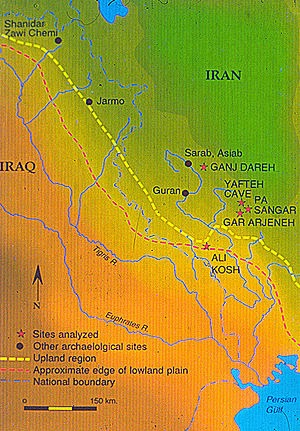
The circular houses of the earliest Neolithic villages have not been found at Mehrgarh. But quadrangular houses built with about 60 cm long narrow bricks with a herringbone pattern of impressions of thumbs to provide a keying for the mud-mortar, have been uncovered at several aceramic Neolithic sites in the Zagros, such as Ganj Dareh or Ali Kosh in the Deh Luran region of Iran, where, like at Mehrgarh, traces of red paint have also been noticed on the walls.
These are very close similarities. The circular houses are the so-called Pre-Pottery (or Aceramic) Neolithic (PPN) A of the Levant and Anatolia, the quadrangular houses the PPN B: it seems that the PPNB people of the Zagros moved directly to Mehrgarh.
As to the burials, already in the French article already cited Jarrige and Lechevallier observed in Ali Kosh and Mehrgarh a similar flexed position of the skeletons, coated with ochre, along with baskets coated with bitumen. In the Pragdhara article, he adds also "oblong-shaped cakes of red-ochre". Moreover, common gravegoods are seashells, turquoise (which was mined in Khorasan, in NE Iran, and also in Kerman, in SE Iran, see here), and even copper beads. This detail of copper already in the Neolithic levels belonging to an age of the 8th-7th mill. BC is remarkable, because it shows that the Indo-European term for copper or generally metal (ayas in Sanskrit, aiiah in Avestan, aes in Latin, aiz in Gothic) could be developed already in such an old Neolithic period (see also here about the presence of copper in Mesopotamia around 8700 BC).
Moreover, in Mehrgarh as well as in Ali Kosh and Ganj Dareh, the skeletons of children are the most richly adorned. In Sang-e Chakhmaq, in Northern Iran (south of the Alborz mountains), a site recently investigated again, a 10 month fetus was buried with 183 shell beads and 90 clay beads in the West Tappeh, dated from the end of the 8th to the early 7th mill. BC. Also there, the bodies were lying in a contracted position on the side, a burial form that according to a paper presented this year, is found in other Iranian sites like Sialk, Tepe Hissar, Shah Tepe, and Shar-i Sokhta. Thus, already in the earliest Neolithic, we find a common culture from the Zagros to northern Iran to Baluchistan. J.F. Jarrige speaks of "a sort of cultural continuum", and Catherine Jarrige, in The figurines of the first farmers at Mehrgarh and their offshoots (also in Pragdhara 18), writes about the clay figurines:
the early figurines of Mehrgarh are an essential component in the vast geographical zone which extends from Central Asia to the Zagros, whose ramifications will reach even further during the 2nd millennium. [...] These symbols circulate through the same exchange networks as raw materials, technology and funerary pratices and reveal the links, the contacts and the exchanges which occur between the different regions bounded by the Zagros flanks, Baluchistan and the Indus, the Kara Kum desert and the Makran coast.
Also the paper on Sang-e Chakhmaq compares the figurines found there to those of Jarmo in the Zagros.
The next step is agriculture. In a 2013 paper Riehl from the University of Tübingen (see also here) analyzes a Neolithic site of the Zagros, Chogha Golan, and finds there proofs of a progressive domestication of emmer from 9800 BP; moreover, there were wild barley, different wheat species, lentils and peas. So, all the elements for developing a the farming lifestyle were present, including goats (Ganj Dareh on the Zagros is one of the first sites for domesticated goats, 10000 yr BP, see here), and most of the same elements are found in Neolithic Mehrgarh and other contemporary sites in Iran: emmer and other wheat species, barley, goats.
About barley, there is a map to show:
The blue dots and asterisks are the places with wild barley belonging to the 'western cluster', the red dots and asterisks are those with wild barley of the 'eastern cluster'. The triangles with the names are the Neolithic sites with domesticated barley. As we can see, the barley of the eastern type is found in the Iranian area. The difference is due to the Zagros mountains but probably also to the diffusion of a different domesticated barley, because often wild barley derives from cultivated barley. As the authors (Morell and Clegg) of the paper write:
Geographic patterns of genetic differentiation are associated with the major topographic feature within the range of wild barley, namely the Zagros Mountains (Fig. 1), that trend northwest to southeast and roughly bisect the range of the species. The Zagros also delineate the eastern edge of the Fertile Crescent; thus, the most dramatic differences in haplotype composition in wild barley occur between the Fertile Crescent and the portion of the range east of the Zagros (17). Differences in haplotype frequencies among regions also suggest that human activity, including transportation of cultivated barley among regions, has not homogenized genetic diversity across the range of the wild progenitor.And there is also a map of cultivated barley races:
Here we see how the cultivated barley of Iran belongs to the eastern type, especially in the Zagros, and also in the Indian region it is mainly of the eastern cluster. As the authors say "Accessions from the Zagros Mountains and Caspian Sea region show the lowest probability of origin in the Fertile Crescent (Fig. 2 and SI Fig. 5)." And the conclusion is that the Zagros can be the origin of the eastern domesticated barley:
The relatively broad, species-wide sample mesh in the present study suggests an origin of eastern landraces in the western foothills of the Zagros or points farther east. Much of the region immediately east of the Zagros is a high-elevation plateau, where both wild barley populations (4) and known human Neolithic sites are relatively rare (5). However, the locations of early Neolithic agropastoral settlements suggest three general regions in which the secondary domestication could have taken place. In the foothills of the Zagros, at such sites as Ali Kosh and Jarmo (Fig. 1), domesticated barley is dated to ≈7,000–8,000 cal. B.C. Domesticated barley is found at the Indus Valley site of Mehrgarh (in present day Pakistan) from ≈7,000 cal. B.C. Finally, in the piedmont zone between the Kopet Dag mountain range and Kara Kum Desert (east of the Caspian Sea in present day Turkmenistan), cultivated barley was present by ≈6,000 cal. B.C.
We can add that Fuller, in a paper on Sang-e Chakhmaq (see above), which is more ancient than the Kopet Dag sites and probably a source of them, remarks that there is no evidence there for local domestication although there is also wild barley. But there is more. In a 2008 paper by Huw Jones et al. we read:
The foothills of the Zagros Mountains are among the 3 general regions suggested as centers for a secondary domestication of barley (Morrell and Clegg 2007). One of the 2 wild barleys that our analysis suggests as likely progenitors of the nonresponsive cultivated barleys was sampled in this region (HOR 2882, 32°33′N, 48°33′E). The second of these accessions originates in the north of the Zagros Range (HOR 2680 36°30′N, 48°42′E).
'Nonresponsive' hear means that its flowering is not conditioned by the length of the daylight. It is a special variety which is found also in European cultivated barley races, but more in the continental regions than in the Mediterranean ones, as shown in the black dots in the map below.
And these races appear to have a coalescent age later than the responsive ones:
"barley with the nonresponsive form (ppd-H1) dispersed into Europe more recently than barley with the responsive form. If the Group A haplotypes do represent a later spread of domesticated barley into Europe from Iran, as suggested for crops such as the oil plant Lallemantia, introduced during the Bronze Age (Jones and Valamoti 2005), this raises the possibility that these nonresponsive landraces spread to northern Europe not via Turkey and Greece but through Transcaucasia and around the north coast of the Black Sea."
Or maybe, we can suggest, from Central Asia itself, brought by Indo-Europeans in the Late Neolithic. But for migrations of Indo-Europeans towards Europe we should indeed consider also the Caucasus route, as we see from the Maykop culture of the 4th mill. BC, which reveals strong links with Iran and South Central Asia, but I will come back to this topic in a next post.
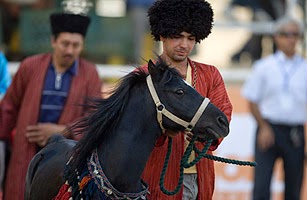 |
| Caspian horse |
The next step is about the horse. The assumption that domesticated horses came exclusively from the steppes is apparently wrong. Ivanova writes that horse bones have been found at Tepe Zaghe near the Alborz in a level of the 6th mill. BC, then in Ghabristan in the same area in the 4th mill., at Tall-i-Iblis in South-central Iran remains of horses belong to 3500 and 3000 BC (here dated also 4400-4100), and in Godin Tepe IV in the central Zagros to 2900-2400 BC (see here). Also Mundigak in Afghanistan has given ancient traces of domesticated horses in Neolithic levels (see here), and Tepe Siyalk around 5000 BC (see here). And probably many cases of alleged Equus hemionus (onager) are in reality horses, because in Iran there is a special breed, discovered only in 1965 in the Caspian region, which can be confounded with the onager for the slenderness of the metapodials, as observed by Bokonyi. After his study of Caspian horses, he could identify also bones of equids from Neolithic Anau in Turkmenistan (4000 BC) as horses and not onagers. So, also the remarks of this 1974 study of the fauna of the Zarzian Palegawra cave must be reconsidered, suggesting that some of the alleged onagers were actually horses.
Moreover, in a recent excavation in Mazandaran at Gohar Tappeh, remains of the Caspian horse were found in a cemetery dated 3400 BC. All these dates do not match with the mythical arrival of the steppe horsemen in the 2nd mill. BC, but reveal a presence of particular breeds of horses already in Neolithic times in Iran and South Central Asia.
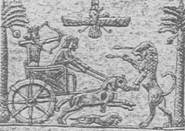
Louise Firouz, the discoverer of the Caspian breed, writes (see here) that there was a tiny wild horse in the Zagros mountains of western Iran, and also possibly south of the Alborz mountains, already during the Ice Age. She also remarks that this horse appears on Sumerian terracotta plaques from the 3rd mill. BC, showing small boys riding the tiny horse. It is known that the Sumerian name of the horse was ANŠE.KU.RA, 'ass of the mountains'. M.J. Shendge notes a cylinder seal from Susa with a scene of horse capture, dated at least 3150-2900 BC. All this suggests that these Zagros horses were known and domesticated at that time, and they appear again on Achaemenian seals like this on the left. Moreover, Herodotus wrote that the horses of the Medes (inhabitants of Western Iran) were particularly small, as is shown also from this Assyrian relief below (from here).
But it is also remarkable that the Caspian horse, according to a genetic study, has the most primitive position in the group of three breeds (the others are Yabou and Turkoman) which represent "the most primitive (ancestral) breeds of the Oriental cluster". What is the Oriental cluster? It is the kind of horse breeds including the Arabian, the Kurd and the Turkmen Akhal Teke: they are slender and fit for dry climates, different in many features from the 'Occidental' horses, and more similar to asses.
We can understand how important this is for the Indo-European question. If horses were already present in Iran in the Neolithic, the name of the horse, so typically Indo-European and found from Sanskrit aśva to Latin equus, could be already present in the Zagros region in the Mesolithic, and the horses found in different Indo-European cultures were not necessarily brought from the Central Asian steppes, but also from Iran. If we look at Anatolian and Greek horses in reliefs and statues, they often belong to the Oriental type. The same probably for Indian horses, which were described in the Rigveda as having 34 ribs as the Arabian horse (and Southeastern Asian breeds like the Timor pony of probable Indian origin, see here), and were also described as particularly small by Herodotus.
The next step is human genetics. In a paper by Underhill et al. published in March 2014, the origin of the Y-DNA haplogroup R1a is given. This haplogroup, that is found particularly in Slavs, Central Asian Iranians and North Indians, was initially associated with Ukraine as the clear trace of 'Kurgan' expansion. Then, someone discovered that the STR diversity is highest in South Asia, which was interpreted as a proof of a more ancient history of this haplogroup there; therefore the theory of an Indian origin appeared, and genetics suddenly became no more significant for the invasionists. Moreover, the typical European R1a (M458) is not found in India. But it was also observed that South Asia had limited SNP subclades, and the most ancient branches have been found in the region of Iran or Eastern Anatolia. Thus the abstract says:
The spatial frequency distributions of R1a sub-haplogroups conclusively indicate two major groups, one found primarily in Europe and the other confined to Central and South Asia. Beyond the major European versus Asian dichotomy, we describe several younger sub-haplogroups. Based on spatial distributions and diversity patterns within the R1a-M420 clade, particularly rare basal branches detected primarily within Iran and eastern Turkey, we conclude that the initial episodes of haplogroup R1a diversification likely occurred in the vicinity of present-day Iran.A more detailed account is quoted by Maju in his post on this paper:
To infer the geographic origin of hg R1a-M420, we identified populations harboring at least one of the two most basal haplogroups and possessing high haplogroup diversity. Among the 120 populations with sample sizes of at least 50 individuals and with at least 10% occurrence of R1a, just 6 met these criteria, and 5 of these 6 populations reside in modern-day Iran. Haplogroup diversities among the six populations ranged from 0.78 to 0.86 (Supplementary Table 4). Of the 24 R1a-M420*(xSRY10831.2) chromosomes in our data set, 18 were sampled in Iran and 3 were from eastern Turkey. Similarly, five of the six observed R1a1-SRY10831.2*(xM417/Page7) chromosomes were also from Iran, with the sixth occurring in a Kabardin individual from the Caucasus. Owing to the prevalence of basal lineages and the high levels of haplogroup diversities in the region, we find a compelling case for the Middle East, possibly near present-day Iran, as the geographic origin of hg R1a.
Among the Iranian M420* cases in Underhill's paper, the highest frequency (1.7%, 5 on 297) is found in the Iranian Azeris, who live just to the north of the Zagros and have Median ancestors. But a similar frequency (1,2%) is also in Iran North and Iran South, and in a larger sample (5 on 403 in the North, 5 on 408 in the South). The highest frequency in general is in Cappadocia, Turkey, 2.2%, but on a sample of only 93 persons. Cappadocia however is a significant region, because there was Kanesh or Neša, the first center of the Hittites in Anatolia, so that their language was called Nešili; morevoer, it had centuries of Persian domination (see here), and consequently local noblemen of Persian descent, like Ariobarzanes in the Roman period.
The Kabardin R1a1-SRY10831.2* is interesting, because the Kabardins live in a region were the Maykop culture was present, a region which could be reached from Iran through the Caucasus: the Iranian heritage there is revealed also by the name of the main mountain of the region, the Elbrus, corresponding to the Alborz in Iran and the Harā Bərəzaitī of the Avesta. It is also remarkable that 3 Kabardins in the list of this paper have Z93, which is the typical Asian R1a. The Iranian cases of R1a1-SRY10831.2* belong to Northeast, North and South Iran, and one case taken from the study of Regueiro comes from North Iran.
We can add the discovery of a R1a* haplotype in a Yezidi Kurd reported by the blog KurdishDNA. The Yezidis or Yazidis, who have recently become sadly famous for the recent persecution by the jihadists in Iraq, have preserved ancient Iranian religious traditions and their main shrine is in Laliş on the mountains north of Mosul. Thus, we have come back close to the region from which we have started, the area of the Zarzian culture, which is presently inhabited by Kurds. The paper by Grugni et al. says about them:
The prehistory of the Kurds is poorly known, but their ancestors seem to have inhabited the same inhospitable mountainous region for millennia remaining relatively unmixed with the invaders. The records of the early empires of Mesopotamia contain frequent references to mountain tribes with names resembling ‘‘Kurd’’. They inhabit broad lands from the Azerbaijan to Khuzestan but in the 17th century a large number of Kurds were also present in Khorasan.
According to that study, the main haplogroup in Iranian Kurds is R1a1a* (M198*), with 20.3% (12 on 59).
In the table S7 we have the ages of microsatellite variation of R1a-M198* in different populations. The highest is in Nepal (17.5+/-5 kya), and in Pakistan (17.5+/-3.2), followed by India (16.5+/-3.5) and South Iran (15.2+/-4.2). Iran in general has 14.6, Caucasus and Poland have 13.6, Germany 12.1, Russia 9.5 kya. It is clear that all these estimates are improbable and inconsistent with the ancient DNA: the most ancient case of R1a in Europe is from the Corded Ware burials of Eulau, less than 5 kya. And the most ancient date in Nepal or Pakistan is not consistent with the presence of the ancestral chromosomes in Iran. The high variance in South Asia can be explained with the large population and with multiple arrivals of carriers of R1a in that region; anyway an ancient presence there, more ancient than in Europe, seems clear.
In the table S7 we have the ages of microsatellite variation of R1a-M198* in different populations. The highest is in Nepal (17.5+/-5 kya), and in Pakistan (17.5+/-3.2), followed by India (16.5+/-3.5) and South Iran (15.2+/-4.2). Iran in general has 14.6, Caucasus and Poland have 13.6, Germany 12.1, Russia 9.5 kya. It is clear that all these estimates are improbable and inconsistent with the ancient DNA: the most ancient case of R1a in Europe is from the Corded Ware burials of Eulau, less than 5 kya. And the most ancient date in Nepal or Pakistan is not consistent with the presence of the ancestral chromosomes in Iran. The high variance in South Asia can be explained with the large population and with multiple arrivals of carriers of R1a in that region; anyway an ancient presence there, more ancient than in Europe, seems clear.


